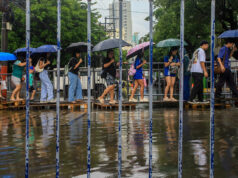Only 50% of Filipino adults have financial accounts — World Bank

ONLY 50% of Filipino adults had financial accounts at end-2024 even as 78% own mobile phones, according to the World Bank.
The World Bank said in The Global Findex Database 2025 report released on Wednesday that 50.2% of approximately 82 million Filipinos aged 15 years old and above had financial accounts in 2024, lower than the 51.4% recorded in 2021 but higher than 26.6% in 2011.
This is below the 83.3% average account ownership rate for East Asia and Pacific (EAP) and the 70.4% for lower middle-income countries.
The EAP region is composed of the Philippines, Cambodia, China, Indonesia, Lao People’s Democratic Republic, Malaysia, Mongolia, Myanmar, Thailand, and Vietnam.
Worldwide, 78.7% of adults had financial accounts in 2024, up from 73.8% in 2021 and 50.6% in 2011.
The study is based on surveys conducted in 141 economies in 2024 and includes financial inclusion indicators such as access to formal and nonformal financial services, payments, and saving and borrowing behavior, among others.
The 2025 report also includes new data on ownership of mobile phones and internet use from the inaugural Global Findex Digital Connectivity Tracker.
“Mobile phones and the internet are revolutionizing financial inclusion, enabling more people to access and use digital financial services to manage their financial lives. From mobile money accounts accessible on basic phones to bank-account-linked wallets used on smartphones, digital services are fulfilling their promise of being more accessible and affordable than alternatives that are not digitally accessible, bringing benefits such as the ability to make daily savings deposits using local agents, to manage loan disbursements and repayments using an app, and to purchase pay-as-you-go renewable electricity directly from a phone, to name just a few,” the World Bank said.
“The data show high levels of phone ownership and internet use and increased ownership and usage of mobile-enabled accounts in every region of the world. Mobile platforms in particular have given millions of people, including those who were previously too difficult or too expensive to reach, access to financial services, dramatically boosting not just account ownership, but also formal saving and digital payments, while in addition enabling a range of nonfinancial digital activities.”
In the Philippines, 78% of adults had personal mobile phones in 2024, below the 94% average in East Asia and Pacific but slightly above the 75.1% average for lower middle-income economies.
Meanwhile, 69% of Filipino adults had personal smartphones, lower than the EAP average of 85.8% but higher than the 50% for lower middle-income countries.
The data showed that 33.5% of Filipino adults had accounts with banks or similar formal financial institutions, while 28.8% had mobile money accounts. Some 32.7% said they had digitally enabled accounts, or those used with a card or phone.
Per sector, account ownership rates among Filipino adults stood at 57.1% for women, 34.4% for those in the poorest 40% of households, 41.3% for those out of the labor force, and 46.5% of those in rural areas. All of these were below the averages seen for both the East Asia and Pacific region and lower middle-income economies.
According to the report, 53.6% of Filipino respondents said they saved formally and informally in the past year, with 23.9% of them saving formally using a financial account, up from the 2021 figure of 20.8%. Meanwhile, 6.3% said they saved informally using a savings club or through a person outside of their family.
“More than 20% of adults saved using a mobile money account in Malaysia, the Philippines, and Thailand as well,” the World Bank said.
As for borrowing, 72% of Filipino adults said they borrowed in the past year, with only 12% doing so via formal channels.
Meanwhile, the report showed a slight decrease in the use of digital payments in the Philippines. It said that 40.3% of Filipino adults made or received digital payments in the past year, down from 43.5% in 2021. This is also well below the EAP region average of 80.2% in 2024.
Those who made digital merchant payments stood at 13.4%, lower than 18.5% in 2021.
“Overall, in low- and middle-income economies, 36% of adults bought something online. Of these online shoppers, nearly 20% paid for their online purchases exclusively using cash on delivery,” the World Bank said.
“East Asia and Pacific had the highest share of online shoppers at 65% of all adults, with 87% of shoppers also paying for their purchases online. Yet as with the overall trends in digital merchant payments in the region, rates of adoption of online payment are driven mostly by high usage levels in China. When data for China are excluded, online shopping rates for East Asia and Pacific drop to 34% of adults, with just over half of them, 18%, paying cash on delivery,” it added. “Rates of this behavior are particularly high in certain of the region’s economies. For instance, in Malaysia and Thailand, between 30% and 40% of adults making online purchases pay cash on delivery; in Indonesia and the Philippines, more than half do.”
The World Bank said while growing digital connectivity has driven the increase in financial account ownership and use worldwide, efforts to improve inclusion remain important.
“Dedicated financial inclusion efforts are still critical, however, to address two key challenges. The first is reaching the remaining adults without accounts, primarily women and poor adults, through focused, context-appropriate initiatives. The second is developing programs, policies, and products that help everyone improve their financial health so that they can more effectively mitigate sources of financial worry, increase their financial resilience, and more effectively pursue their goals,” it said.
“Any effort to further expand digital and financial inclusion should take into account the broader context to ensure that the necessary infrastructure and consumer protections are in place. Governments and providers of financial services have a responsibility to establish strong rules ensuring consumer protection and implement them throughout the product design, sales, onboarding, and user experience processes. In this way, they can play a role in designing the next wave of efforts toward financial inclusion for people who remain underserved.” — BVR



